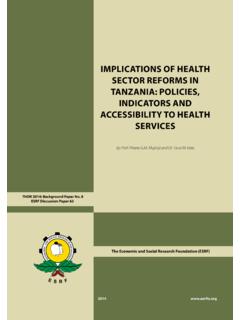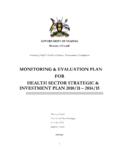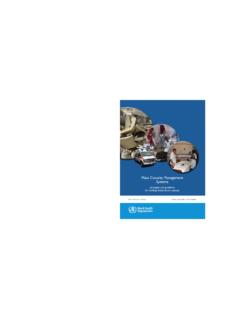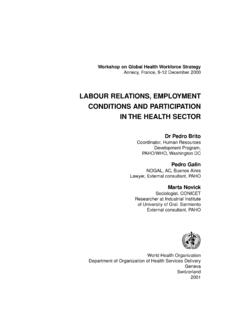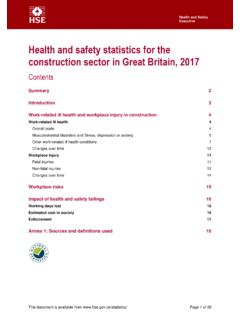Transcription of Situation analysis of the health sector - WHO
1 Chapter 3 Situation analysis of the health sector1 Strategizing national health in the 21st century: a handbookChapter 3 Situation analysis of the health sectorDheepa RajanSAPSSPOPCBME1 PCDCDSlRIASA ShutterstockStrategizing national health in the 21st century: a handbook Chapter 3 Situation analysis of the health sector2 ShutterstockChapter 3 Situation analysis of the health sector3 DHCSNL I Chapter 1 Introduction: strategizing national health in the 21st century PC Chapter 2 Population consultation on needs and expectations SA Chapter 3 Situation analysis of the health sector PS Chapter 4 Priority-setting for national health policies, strategies and plans SP Chapter 5 Strategic planning: transforming priorities into plans OP Chapter 6 Operational planning: transforming plans into action C Chapter 7 Estimating cost implications of a national health policy, strategy or plan B Chapter 8 Budgeting for healthME Chapter 9 Monitoring, evaluation and review of national health policies, strategies and plans Cross-cutting topics relevant to national health planningLR Chapter 10 Law, regulation and strategizing for health Chapter 11 Strategizing for health at sub-national level IP Chapter 12 Intersectoral planning for health and health equity Chapter 13 Strategizing in distressed health contextsSAPSSPOPCBMEIPCSNLLRDHCIPS trategizing national health in the 21st century.
2 A handbook Chapter 3 Situation analysis of the health sector4 Situation analysis of the health sectorDheepa RajanChapter 3 Situation analysis of the health sector5 WHO /Olivier AsselinWHO Library Cataloguing-in-Publication DataStrategizing national health in the 21st century: a handbook / Gerard Schmets .. [et al].Contents: 13 individual Policy. health Programs. Planning. , G rard. , Dheepa. , Sowmya. health OrganizationISBN 978 92 4 154974 5 (NLM classification: WA 540) World health Organization 2016 All rights reserved. Publications of the World health Organization are available on the WHO website ( ) or can be purchased from WHO Press, World health Organization, 20 Avenue Appia, 1211 Geneva 27, Switzerland (tel.: +41 22 791 3264; fax: +41 22 791 4857; email: Requests for permission to reproduce or translate WHO publications whether for sale or for non-commercial distribution should be addressed to WHO Press through the WHO website ( ).)
3 The designations employed and the presentation of the material in this publication do not imply the expression of any opinion whatsoever on the part of the World health Organization concerning the legal status of any country, territory, city or area or of its authorities, or concerning the delimitation of its frontiers or boundaries. Dotted and dashed lines on maps represent approximate border lines for which there may not yet be full agreement. The mention of specific companies or of certain manufacturers products does not imply that they are endorsed or recommended by the World health Organization in preference to others of a similar nature that are not mentioned. Errors and omissions excepted, the names of proprietary products are distinguished by initial capital letters.
4 All reasonable precautions have been taken by the World health Organ-ization to verify the information contained in this publication. However, the published material is being distributed without warranty of any kind, either expressed or implied. The responsibility for the interpretation and use of the material lies with the reader. In no event shall the World health Organization be liable for damages arising from its use. The named editors have overall responsibility for the views expressed in this publication. The named authors alone are responsible for the views expressed in each chapter. The document has been produced with the financial assistance of the European Union and the Grand Duchy of Luxembourg. The views expressed herein can in no way be taken to reflect the official opinion of the European Union nor the Grand Duchy of Luxembourg.
5 Graphic design by Valerie citation: Rajan D. Chapter 3. Situation analysis of the health sector . In: Schmets G, Rajan D, Kadandale S, editors. Strategizing national health in the 21st century: a handbook. Geneva: World health Organization; national health in the 21st century: a handbook Chapter 3 Situation analysis of the health sector6 iiiContentsAcknowledgements ivOverview What do we mean by Situation analysis of the health sector ? 1 What is a Situation analysis ? 1 The spectrum of a Situation analysis Why do we want to undertake a Situation analysis ? 3 It is a crucial step in the planning cycle 3 In order to give a voice and a platform to all health sector stakeholders, including the population 3 In order to increase accountability and transparency 4 In order to support and strengthen monitoring and evaluation 7 It contributes to concretizing roles and responsibilities 8 It helps to establish consensus on the status of health in the country When should the Situation analysis take place?
6 Who should be involved in the Situation analysis ? 12 Ministry of health 13 Civil society, including professional associations and special interest groups 13 Private sector 14 Parliament 14 Media 15 Development Partners Methodology: how should a Situation analysis be organized and conducted? 17 Organization of the Situation analysis 17 Three streams of analysis 26 How long does a truly participatory Situation analysis approximately take? 34 Link between Streams 2 and 3 36 Link between Situation analysis and priority-setting Some issues to consider 39 Factors of success 41 Dissemination of Situation analysis results What if.
7 ? 41 What if your country is decentralized? 41 What if fragmentation and/or fragility is an issue in your country? 43 What if your country is highly dependent on aid? Conclusion 47 References 48 Further reading 49 Chapter 3 Situation analysis of the health sector7 ivAcknowledgementsWe would like to give special thanks to Agnes Soucat for overall guidance. Thanks are also due to Alyssa Muggleworth Weaver for overall background research support. WHO interns who supported this chapter were Olaitan Awonusi and Romain Oguey. Frank Terwindt provided information for Table , Box , Box and Fig. Paul provided information for Boxes and document was reviewed by Frank Terwindt, Gerard Schmets, Qaiser Pasha and Humayun Rizwan.
8 The following participants of a retreat in August 2015 provided valuable input into a revised draft of the chapter: Olaitan Awonusi, Maryam Bigdeli, David Clarke, Casey Downey, Sowmya Kadandale, Thomas O Connell, Denis Porignon, Finn Schleimann, G rard Schmets, Archana Shah, Karin Stenberg, Frank Terwindt, and Kavitha language editing was provided by Dorothy van Schooneveld and Thomson Prentice. We gratefully acknowledge financial support from the European Union and the Grand Duchy of national health in the 21st century: a handbook Chapter 3 Situation analysis of the health sector8 OverviewThe strategic directions and the principal orientation of a national health policy, strategy or plan (NHPSP) need to be grounded in a sound understanding of the status of the health sector .
9 This chapter aims to elaborate on a participatory, inclusive health sector Situation analysis methodology to vChapter 3 Situation analysis of the health sector9 WHO /Diego Rodriguezviaddress that simple but very basic need of obtaining a realistic snapshot of the strengths and weaknesses of a country s health system, as well as a more profound understanding of the reasons behind those strengths and weaknesses, so as to better enable a viable alternative (or successful scale-up).Strategizing national health in the 21st century: a handbook Chapter 3 Situation analysis of the health sector10 SummaryWhat is a Situation analysis of the health sector ?A health sector Situation analysis should aim:(a) to realistically assess the current health sector Situation , with all its strengths, weak-nesses opportunities and threats, including their root causes and effects; (b) to provide an evidence-informed basis for responding to health sector needs and expectations of the population;(c) to provide an evidence-informed basis for formulating future strategic directions for the health characteristics of a sound health sector Situation analysis are elaborated upon in this chapter.
10 These are:participatory and inclusive;analytical;relevant;comprehens ive; should a Situation analysis be done?A whole-of- sector Situation analysis is important because:it is a crucial step in the planning cycle;it gives a voice and a platform to all healthsector stakeholders, including the population;it increases accountability and transparency;it supports and strengthens monitoring andevaluation;it contributes to concretizing roles andresponsibilities; andit helps to establish consensus on the statusof health in the 3 Situation analysis of the health sector11 When should a Situation analysis take place?It should be done as a key initial step in the development of a NHPSP. Ideally, it should be undertaken at least once during the health policy and planning cycle, and updated every few years, because an updated, in-depth technical analysis that includes stakeholder viewpoints is an invaluable resource for the whole health should be involved in a health sector Situation analysis ?










